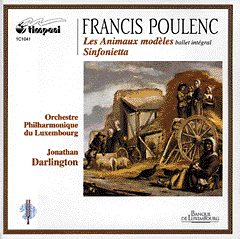|
|
Search MusicWeb Here |
|
 |
||
|
Founder:
Len Mullenger (1942-2025) Editor
in Chief:John Quinn
|
|
|
Search MusicWeb Here |
|
 |
||
|
Founder:
Len Mullenger (1942-2025) Editor
in Chief:John Quinn
|
RECORD OF THE MONTH

|
Francis POULENC (1899-1963)
Les Animaux Modèles (1941) Sinfonietta (1948) Recorded Luxembourg Conservatoire, 15th – 19th September 1997 |
| CD available for post-free online mail-order or you may download individual tracks. For some labels you can download the entire CD with a single click and make HUGE savings. The price you see is the price you pay! The full booklet notes are available on-line. |  |
|
NOTE • Click on the button and you can buy the disc or read the booklet details • You can also access each track which you may then sample or down load. • Further Information. |
|
|
It comes as something of a surprise to realise how little orchestral concert music Poulenc actually composed. If you take away the ballets and the five concerted pieces, the Sinfonietta is all that remains. It is recorded here with the delicious Animaux Modèles suite of 1941, and they make a wonderful coupling, as each combines his skittishness and knockabout humour with a more serious purpose – a duality bordering on confusion that has often brought critical opprobrium down upon Poulenc’s head. On the other hand, it’s exactly what makes him so loveable and instantly recognisable.
Les Animaux Modèles, translated simply as ‘The Model Animals’, is a ballet for which the composer himself wrote the story, working from the fables of La Fontaine. Too involved to give completely here, suffice it to say that the action takes place in a farmyard somewhere in rural France on a hot July morning, as the people and the animals go about the business. Various surreal events take place; a cicada plays the violin, a lion make love to a young girl, cockerels fight to the death, and so on. But there is a serious purpose behind the fable, and the ballet is undoubtedly a parable of wartime France, languishing under Nazi occupation at the time of composition (the composer himself had been recently demobbed as ‘Private Poulenc’). The music is gloriously inventive, and must be ranked amongst his finest work. Le Petit Jour (‘Dawn’) which acts as the Prelude, and is recapitulated partially at the end, has an innocence which brings it close to the Ravel of L’Enfant et les Sortilèges – not inappropriately, for that is another work where animals take centre stage (track 1, beginning). As an old lady crosses the stage on her way to morning prayers, Poulenc cheekily but touchingly quotes from his own Litanies à la Vierge Noire (The same thing happens when she returns at the end of the ballet).
The great central number is Le Lion Amoureux (The Amorous Lion), with a magnificent sweeping melody followed by a jaunty waltz (Track 4, 0:32). The later scene between a lumberjack and the figure of Death has a solemn beauty about it, which lovers of Poulenc’s sacred music will relish. And humour is everywhere, perhaps most notably in the hilarious portrayal of the hens who come out clucking and strutting to watch the cock fight. Somehow, he even manages to capture the mindless beadiness of their expressions – wonderful!
The Sinfonietta is yet another work for which we have to thank the BBC, who wanted a commission from Poulenc to mark the tenth anniversary of the Third Programme. The composer unfortunately missed the deadline (the BBC is familiar with this problem), but delivered it in September 1948. If its status as ‘absolute’ music leads you to expect something more dry or cerebral, you will be woefully wide of the mark. In fact, I wonder if this music has been used as the basis of a ballet? It’s certainly wonderfully entertaining and witty music, The third movement is a charming serenade-like Andante cantabile, where the spirit of Brahms, of all people, seems not far away in the smooth clarinet solo near the start (Track 11, beginning).
Jonathan Darlington seems to me to have the stylistic measure of this music perfectly. He shapes it lovingly, but characterises sharply, securing an ensemble that is tight yet flexible. Though the Luxembourg Philharmonic may not be quite in the very top rank, they play superbly, and I appreciated the very French sound of the woodwind playing, which gives the performances an authentic flavour. The recording is excellent, with an ideal balance, and a well focused but warm sound. Altogether a quite outstanding disc.
Gwyn Parry-Jones
Timpani disc: Samples: 1. Track 1, beginning. 2. Track 4, 0:32 3. Track 11, beginning |
Molto
vivace Finale:
Prestissimo et tres gai Get a free QuickTime download here |
|
ADDITIONAL INFORMATION •
You can sample only 30 seconds (or 15% if that is longer) of a given track. Select from the View tracks list. Each sample will normally start from the beginning but you can drag the slider to any position before pressing play. • PLEASE NOTE: If you are behind a firewall and the sound is prematurely terminated you may need to register Ludwig as a trusted source with your firewall software.
•You will need Quicktime to hear sound samples. Get a free Quicktime download here • If you cannot see the "Sample All Tracks" button you need to download Flash from here.
|
|
|
Return to Index |